Have you ever wanted to recycle some items but didn’t know where to go? Now, there’s an app for that!
Follow the link to learn more about this smartphone app “iRecycle”:
Have you ever wanted to recycle some items but didn’t know where to go? Now, there’s an app for that!
Follow the link to learn more about this smartphone app “iRecycle”:
In an effort to reduce the amount of organic waste produced by the various branches at CEI that utilize the wet-lab facility, a Caribbean Spiny lobster (Panulirus argus) ranching project was initiated in mid-December 2012.
Mature wild-caught lobster were housed in one of the vacant holding tanks in the wet-lab and fed off-cuts, old dissection specimens and any other organic material that would have previously been 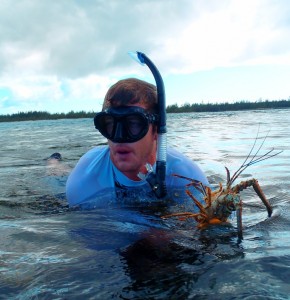 discarded. Due to a lack of published information on ideal stocking densities and holding conditions, another objective of this study is to determine the optimal levels of the above mentioned parameters. A number of capture methods were tested. These include baited cages, pole-snares and by hand. The latter two methods have thus far been the most effective.While the primary focus of this project is waste management, a secondary focus is an attempt to capture Spiny lobster pueruli, pre-settlement. Pueruli refers to a life stage in the lobster between larvae and juvenile. These pueruli are then transported back to the lab, where they are also fed organic waste produced by the lab, chopped into a finer form than that which is given to the mature specimens. Continue reading
discarded. Due to a lack of published information on ideal stocking densities and holding conditions, another objective of this study is to determine the optimal levels of the above mentioned parameters. A number of capture methods were tested. These include baited cages, pole-snares and by hand. The latter two methods have thus far been the most effective.While the primary focus of this project is waste management, a secondary focus is an attempt to capture Spiny lobster pueruli, pre-settlement. Pueruli refers to a life stage in the lobster between larvae and juvenile. These pueruli are then transported back to the lab, where they are also fed organic waste produced by the lab, chopped into a finer form than that which is given to the mature specimens. Continue reading
A group of 12 students, 8th – 12th grade, from Vermont Commons School in South Burlington, Vermont, is off after a week of SCUBA diving and research. This was their first time visiting CEI and they say it exceeded their expectations! They especially enjoyed night wading for octopus with  Brendan Talwar, lionfish dissections with Elizabeth Underwood and Jocelyn Curtis-Quick, learning reef fish ID with Kristal Ambrose, ultimate frisbee with Jason Kincaid, and volunteering with SEEP (South Eleuthera Emergency Partners)! Each and every one of them loved our local lettuce and all the food provided by our kitchen staff. We couldn’t have done it without this amazing community!
Brendan Talwar, lionfish dissections with Elizabeth Underwood and Jocelyn Curtis-Quick, learning reef fish ID with Kristal Ambrose, ultimate frisbee with Jason Kincaid, and volunteering with SEEP (South Eleuthera Emergency Partners)! Each and every one of them loved our local lettuce and all the food provided by our kitchen staff. We couldn’t have done it without this amazing community!

Check out the link to their blog for a step by step log of their trip down to Cape Eleuthera Institute! http://vcsturtledivers.blogspot.com/

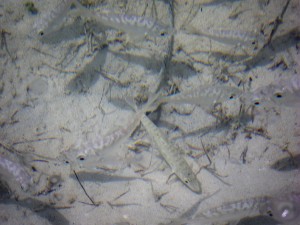 Since May 2011, Christopher Haak, a PhD student (and avid fisherman) at the University of Massachusetts, Amherst, along with other scientists, has been trying to solve the mystery of where juvenile bonefish live, from settlement through the time they join adult populations on the flats. Exhaustive efforts to locate juveniles along the densely-developed coastlines of Florida were met with little success, leading researchers to the comparatively pristine shorelines of The Bahamas to continue their search.
Since May 2011, Christopher Haak, a PhD student (and avid fisherman) at the University of Massachusetts, Amherst, along with other scientists, has been trying to solve the mystery of where juvenile bonefish live, from settlement through the time they join adult populations on the flats. Exhaustive efforts to locate juveniles along the densely-developed coastlines of Florida were met with little success, leading researchers to the comparatively pristine shorelines of The Bahamas to continue their search.
For the past one-and-a-half years, they have scoured the coastlines of South Eleuthera, conducting 1000+ seine hauls, encompassing a broad range of coastal habitats. This project is funded by Bonefish & Tarpon Trust and based out of CEI. These efforts (with the help of South-Eleutherans; thanks Denny and Kelsey Rankin!) have succeeded in locating over 800 juvenile bonefish as small as one inch in length, and have revealed some intriguing trends. For example, contrary to what might be expected, juvenile bonefish do not appear to frequent the mangrove creek systems or expansive tidal flats commonly used by adults, preferring instead to remain along shallow, sheltered shorelines near deeper basins or channels.
Can you find the juvenile bonefish among the mojarra in the picture below?
Last week The Island School hosted 12 SCUBA divers from the New York Harbor School. Accompanying the divers were dive instructors Liv Dillon and Joe Gessert and board member Eli Smith. The divers continue the relationship between the New York Harbor School and The Island School, which includes dive trips such as this one as well as bringing students to enroll in Island School semesters as part of the City Bridge program. Students participated in up to 22 dives (four per day), 10 received their Advanced Open Water Certification, while the other 2 students (who had already completed their Advanced Open Water) worked towards their Divemaster.
For more information on the New York Harbor School, check out their website, and for a glimpse of what the students experienced, check out these photos and the video below:
http://www.youtube.com/watch?feature=player_embedded&v=o01WD8fUUKE
This first GAP year update was written by a gapper reflecting on their first week:
When I asked the copious newcomers that arrived at Cape Eleuthera Institute in the past week or so if they could describe their experience so far, they responded ultimately a plethora of words: surreal, funky fresh, refreshing, really salty, lots of lettuce, and extremely informative. Personally, I would not object to any of those, but due to lack of time, as I am a gap year student here at The Cape Eleuthera Institute, and have to finish my prerequisites for SCUBA training, I am only going to focus on the week being “surreal, informative, and refreshing.”
Along with four other gappers (for the sake of an easier flow to this blog post, and a more real description of our time here, I am going to refer to a gap year student as a “gapper”, what everyone else has come to call us), we arrived at the sunny south side of the island Eleuthera, and it immediately seemed as if the luminous sun hovering the enticing, crystal, teal waters sucked out the oxygen from the moment, where we were all amazed at how perfect a place can really be. Continue reading
From December 27th, 2012 to January 10th, 2013 a field course from Carleton University, led by Dr. Nigel Waltho and coordinated by the Ontario Universities Program in Field Biology, came to CEI to 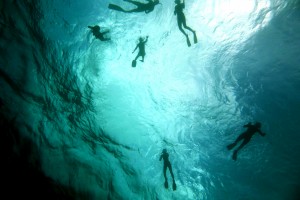 conduct reef ecology research. Through snorkeling and scuba diving, 8 teams of students studied the distribution and community organization of various marine habitats as it relates to ecological processes. Some examples of projects included studying the effects of the lionfish invasion on fish community structure, studying fish species richness and abundance relative to a gradient of habitat types, as well as interspecific competition for space among corals, sponge and algal species.
conduct reef ecology research. Through snorkeling and scuba diving, 8 teams of students studied the distribution and community organization of various marine habitats as it relates to ecological processes. Some examples of projects included studying the effects of the lionfish invasion on fish community structure, studying fish species richness and abundance relative to a gradient of habitat types, as well as interspecific competition for space among corals, sponge and algal species.
The course included writing a proposal, species identification,  project design, data collection, statistical workshops, and a final scientific paper. These final reports, in addition to their publication potential, will have the opportunity to be used by the Bahamian government to inform local conservation efforts. Highlights from the trip included seeing a whale shark, squid, eagle rays, a hammerhead shark as well as attending local Bahamian Junkanoo festivals and exploring the island!
project design, data collection, statistical workshops, and a final scientific paper. These final reports, in addition to their publication potential, will have the opportunity to be used by the Bahamian government to inform local conservation efforts. Highlights from the trip included seeing a whale shark, squid, eagle rays, a hammerhead shark as well as attending local Bahamian Junkanoo festivals and exploring the island!
January 2013 has seen lots of action at CEI; programs are visiting, research is ongoing, and buildings are going up. Carter Brown (SP09) visited CEI for a week to assist with construction of the new recycling facility on campus. While on Eleuthera, Carter installed the first completed segments of the building’s glass bottle walls, demonstrating reuse at its best!
Carter created a mosaic of color that both permits natural lighting to the building and makes use of bottles collected over the last several months. Nice work, Carter!
Recently, students from the Maine School of Science and Mathematics (MSSM), hailing from 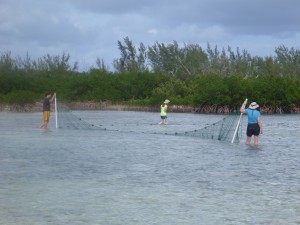 Limestone, Maine, spent their 2 week J-Term learning about sea turtle research and conservation at CEI.While here they learned about how the Bahamas is a unique foraging ground for juvenile green sea turtles. The students traveled to Half Sound, located northwest of the Cape, on the Atlantic side of the island. This site provides a protected habitat with a small opening to the ocean, a seemingly ideal place for juvenile green sea turtles to forage.
Limestone, Maine, spent their 2 week J-Term learning about sea turtle research and conservation at CEI.While here they learned about how the Bahamas is a unique foraging ground for juvenile green sea turtles. The students traveled to Half Sound, located northwest of the Cape, on the Atlantic side of the island. This site provides a protected habitat with a small opening to the ocean, a seemingly ideal place for juvenile green sea turtles to forage.
For their research, MSSM students built on research conducted by Annabelle Brooks and The Island School Fall 2012 research group. During their field time they conducted habitat mapping and surveys of the sound- observing shoreline habitat, taking depth measurements, and noting bottom type. They also set up the first baited remote underwater video (BRUV) in the sound to capture footage of the possible predators in the sound. Boat surveys were conducted, where students did actual counts of sea turtles, and a seine net was set up in the mouth of the tidal creek, to capture and tag sea turtles. The tagging of sea turtles done at CEI is in partnership with the Archie Carr Center for Sea Turtle Research at the University of Florida, which aims to form a global database of sea turtle tagging data.
Over the holiday break, CEI Lionfish Research and Education Program Manager Dr. Jocelyn 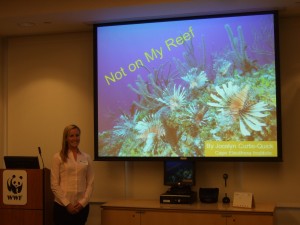 Curtis-Quick took a trip to the states to promote CEI lionfish research. She traveled to the World Wildlife Fund (WWF) headquarters in Washington, D.C., and presented a talk entitled “Not on my reef,” discussing the threat of invasive lionfish to Caribbean marine ecosystems, and efforts to mitigate the problem. She also presented on other current CEI research, while highlighting the organizations’ goals of research, outreach, and education. Thanks Jocelyn!
Curtis-Quick took a trip to the states to promote CEI lionfish research. She traveled to the World Wildlife Fund (WWF) headquarters in Washington, D.C., and presented a talk entitled “Not on my reef,” discussing the threat of invasive lionfish to Caribbean marine ecosystems, and efforts to mitigate the problem. She also presented on other current CEI research, while highlighting the organizations’ goals of research, outreach, and education. Thanks Jocelyn!